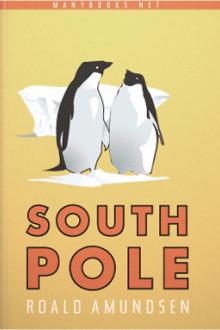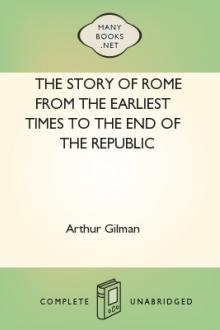A Book of Discovery by M. B. Synge (the snowy day read aloud txt) 📕

- Author: M. B. Synge
- Performer: -
Book online «A Book of Discovery by M. B. Synge (the snowy day read aloud txt) 📕». Author M. B. Synge
From De Bry's account of the Voyages to India, 1601.
At last the preparations were complete. The Santa Maria was to lead the way with the Admiral on board; she was but one hundred tons' burden, with a high poop and a forecastle. It had been difficult enough to find a crew; men were shy about venturing with this stranger from Genoa on unknown seas, and it was a motley party that finally took service under Columbus. The second ship, the Pinta, was but half the size of the flagship; she had a crew of eighteen and was the fastest sailer of the little squadron, while the third, the Nina of forty tons, also carried eighteen men.
COLUMBUS'S SHIP, THE SANTA MARIA COLUMBUS'S SHIP, THE SANTA MARIA.From a woodcut of 1493 supposed to be after a drawing by Columbus himself.
On 3rd August 1492 the little fleet sailed forth from Spain on a quest more perilous perhaps than any yet on record. No longer could they sail along with a coast always in sight; day after day and night after night they must sail on an unknown sea in search of an unknown land. No one ever expected to see them again. It has well been said that, "looking back at all that has grown out of it in the four centuries that have elapsed, we now know that the sailing of those three little boats over the bar was, since the Fall of Rome, the most momentous event in the world's history." The ships steered for the Canary Islands, and it was not till 9th September that the last land faded from the eyes of that daring little company.
Something of a panic among the sailors ensued when they realised their helpless position; some even burst into tears, begging to be taken home. The days passed on. By the 16th they had come within the influence of the trade winds.
"The weather was like April," says Columbus in his journal. Still westward they sailed, eagerly looking for signs of land. Now they see two pelicans, "an indication that land was near," now a large dark cloud to the north, another "sign that land is near."
As the days pass on, their hopes die away and "the temper of the crews was getting uglier and uglier as the three little vessels forged westward through the blue weed-strewn waters." On 9th October hope revives; all night they hear birds passing through the still air.
THE BEST PORTRAIT OF COLUMBUS THE BEST PORTRAIT OF COLUMBUS.From the original painting (by an unknown artist) in the Naval Museum at Madrid.
On the evening of the 11th a light was seen glimmering in the distance; from the high stern deck of the Santa Maria it could be plainly seen, and when the sun rose on that memorable morning the low shores of land a few miles distant could be plainly seen. "Seabirds are wheeling overhead heedless of the intruders, but on the shore human beings are assembling to watch the strange birds which now spread their wings and sail towards the island.
"The Pinta leads and her crew are raising the 'Te Deum.' The crews of the Santa Maria and the Nina join in the solemn chant and many rough men brush away tears. Columbus, the two Pinzons, and some of the men step into the cutter and row to the shore." Columbus, fully armed under his scarlet cloak, sprang ashore, the unclothed natives fleeing away at sight of the first white man who had ever stepped on their shores. Then, unfurling the royal standard of Spain and setting up a large cross, the great navigator fell on his knees and gave thanks to God for this triumphant ending to his perilous voyage. He named the island San Salvador and formally took possession of it for Spain. It was one of the Bahama group, and is now known as Watling Island (British).
"Thus was the mighty enterprise achieved, mighty in its conception, still more important in its results."
But Columbus thought he had discovered the Indies, a new route to the east and the Cathay of Marco Polo. He had done more than this; he had discovered another continent. He had sailed over three thousand miles without seeing land, a feat unparalleled in the former history of discovery.
He made friends with the natives, who resembled those of the Canary Islands. "I believe they would easily become Christians," wrote Columbus. "If it please our Lord at the time of my departure, I will take six from here that they may learn to speak." He also notes that they will make good slaves.
COLUMBUS LANDING ON HISPANIOLA COLUMBUS LANDING ON HISPANIOLA.From a woodcut of 1494.
From island to island he now made his way, guided by natives. He hoped to find gold; he hoped to find Cathay, for he had a letter from Ferdinand and Isabella to deliver to the Great Khan. The charm and beauty of these enchanted islands were a source of joy to the explorer: "The singing of the little birds is such that it appears a man would wish never to leave here, and the flocks of parrots obscure the sun." The island of Cuba "seemed like heaven itself," but Columbus could not forget that he was searching for gold, for Oriental spices, for the land of Marco Polo, as he hastened from point to point, from island to island. Already the Pinta under Martin Pinzon had gone off independently in search of a vague land of gold, to the vexation of the Admiral. A worse disaster was now to befall him. On Christmas Day, off the island of Hayti, the Santa Maria struck upon a reef and went over. Columbus and his crew escaped on board the little Nina. But she was too small to carry home the double crew, and Columbus made a little fortress on the island where the native King was friendly, and left there a little colony of Spaniards.
He now prepared for the homeward voyage, and one January day in 1493 he left the newly discovered islands and set his face for home in company with the Pinta, which by this time had returned to him. For some weeks they got on fairly well. Then the wind rose. A violent storm came on; the sea was terrible, the waves breaking right over the little homeward-bound ships, which tossed about helplessly for long days and nights. Suddenly the Pinta disappeared. The wind and sea increased. The little forty-ton Nina was in extreme peril, and the crew gave themselves up for lost; their provisions were nearly finished. Columbus was agonised lest he should perish and the news of his great discovery should never reach Spain. Taking a piece of parchment, he noted down as best he could amid the tossing of the ship a brief account of his work, and, wrapping it in a waxed cloth, he put it into an empty cask and threw it overboard. Then, while the mountainous seas threatened momentary destruction, he waited and prayed.
Slowly the storm abated, and on 18th February they reached the Azores. A few days for refreshment and on he sailed again, feverishly anxious to reach Spain and proclaim his great news. But on 3rd March the wind again rose to a hurricane and death stared the crew in the face. Still, "under bare poles and in a heavy cross-sea," they scudded on, until they reached the mouth of the Tagus. The news of his arrival soon spread, and excited crowds hurried to see the little ship that had crossed the fierce Atlantic. Bartholomew Diaz came aboard the Nina, and for a short time the two greatest explorers of their century were together. An enthusiastic welcome awaited him in Spain. Was he not the "Admiral of the Ocean Sea, Viceroy of the Western Indies," the only man who had crossed the unknown for the sake of a cherished dream?
"Seven months had passed since Columbus had sailed from Spain in the dim light of that summer morning. Now he was back. Through tempestuous seas and raging winter gales he had guided his ship well, and Spain knew how to do him honour. His journey from the coast to the Court was like a royal progress. The roads were lined with excited people; the air was rent with shouts of joy."
THE FIRST REPRESENTATION OF THE PEOPLE OF THE NEW WORLD THE FIRST REPRESENTATION OF THE PEOPLE OF THE NEW WORLD.From a woodcut published at Augsburg between 1497 and 1504. The only copy known is in the British Museum. The inscription states that the Americans "eat each other," "become a hundred and fifty years of age, and have no government."
On Palm Sunday, 1493, he passed through the streets of Seville. A procession preceded him in which walked the six natives, or Indians as they were called, brought home by Columbus; parrots and other birds with strange and radiant colouring were also borne before the triumphant explorer, who himself rode on horseback among the mounted chivalry of Spain. From windows and roofs a dense throng watched Christopher Columbus as he rode through the streets of Seville. From here he passed on to Barcelona, to be received by the King and Queen.
"The city decked herselfTo meet me, roar'd my name: the king, the queen,
Bad me be seated, speak, and tell them all
The story of my voyage, and while I spoke
The crowd's roar fell as at the 'Peace be still.'
And when I ceased to speak, the king, the queen,
Sank from their thrones, and melted into tears,
And knelt, and lifted hand and heart and voice
In praise to God who led me thro' the waste.
And then the great 'Laudamus' rose to heaven."
It is curious to think what a strange mistake caused all their rejoicing. Not only Spain, but the whole civilised world firmly believed that Columbus had discovered some islands off the coast of Asia, not far from the land of the Great Khan, in the Indian seas. Hence the islands were called the West Indies, which name they have kept to this day.
The departure of Columbus six months later on his second voyage was a great contrast to the uncertain start of a year ago. The new fleet was ready by September 1493. The three largest ships were some four hundred tons' burden, with fourteen smaller craft and crews of fifteen thousand men. There was no dearth of volunteers this time. High-born Spaniards, thirsting for the wealth of the Indies, offered their services, while Columbus took his brother James and a Benedictine monk chosen by the Pope. They took orange and lemon seeds for planting in the new islands, horses, pigs, bulls, cows, sheep, and goats, besides fruit and vegetables.
So, full of hope and joyful expectation, they set sail; and so well had Columbus calculated his distance and direction with but imperfect instruments at his disposal, that he arrived at the islands again on 3rd November. It was another new island, which he named Domenica, as the day was Sunday. Making for the island of Hayti, where he had left his little Spanish colony, he passed many islands, naming Guadeloupe, San Martin, Santa Cruz, and others. Porto Rico was also found, but they arrived at Hayti to find no trace of Spaniards.





Comments (0)